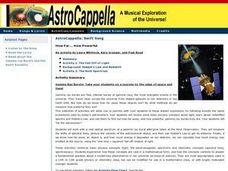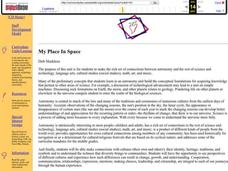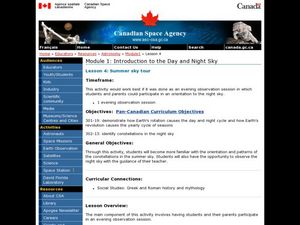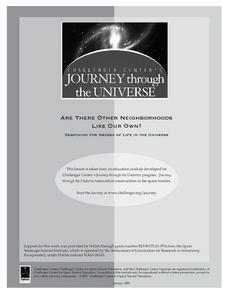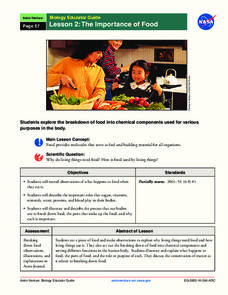Curated OER
Galaxies
Tenth graders explore the structure and content of galaxies. Through discussion, lab, and hands-on activities, they discover the general structure of the three types of galaxies as well as the effect they have on the structure and...
Curated OER
Stellar Discoveries That Are Out of This World
Students hear of the recent discovery of a group of planets orbiting the star Upsilon Andromedae. Each student create a page about an element of the universe,
Curated OER
Hot Air
Students conduct an experiment to determine how hot air affect the path of laser. In this physics instructional activity, students explain why stars appear to twinkle at night. They discuss how light travels from space to Earth.
Curated OER
Why Do We Have Night?
Learners engage in a fun, creative way to discover how the Earth moves. This lesson helps students explain why there is day and night. It can also create curiosity to further study the solar system and eclipses!
Curated OER
Islamic Scientific Contributions to Civilization
Seventh graders explore several well documented artistic and scientific accomplishments that were discovered or perfected during The Golden Age of Islam. They are staff writers of a magazine who create a feature article about a topic...
Curated OER
Egypt's golden Empire
Students explore many of the key scientific and technological contributions made by the ancient Egyptians. Researched data is presented to the entire group.
Curated OER
A Tour of Saturn and Uranus
Second graders draw and label each planet, Saturn and Uranus, showing 2 specific individual characteristics of each.
Curated OER
On the Shoulders of Giants
Students select an astronomer or scientist from the past, research the role that they played in the development of the heliocentric revolution, and make presentations on their achievements.
Curated OER
How Far... How Powerfu
Young scholars work with a real optical spectrum of a gamma ray burst afterglow taken at the Keck Observatory. They measure the shifts of spectral lines, deduce the velocity of the astronomical object, and then use Hubble's Law to get...
Curated OER
Astro-Madness
Students study the different telescopes and instruments used in the Observatory. In this engineering and research lesson plan students explore telescopes using a website and build data tables about them.
Curated OER
My Place In Space
The purpose of this unit is for students to make the rich set of connections between astronomy and the rest of science and technology, language arts, cultural studies (social studies), math, art, and music.
Curated OER
Summer Sky Tour
Middle schoolers explore space science by participating in a constellation identification activity. In this astronomy lesson, students view star charts based on the different seasons and define a list of astronomy related terms. Middle...
Curated OER
It's Just a Phase
Sixth graders are introduced to the correct terminology for the phases of the moon and arrange picture cards in the correct order. They use flashlights and Styrofoam balls to illustrate the phases of the moon. They write science journal...
Curated OER
Introduction to Constellations
Students examine constellations. In this astronomy lesson, students study various constellations and identify five major constellations. They will construct a model of one of the constellations.
Curated OER
The Celestial Sphere and Circumpolar Motion
Students investigate the celestial sphere and circumpolar motion. For this science lesson, students view an applet, The Celestial Sphere and Circumpolar Motion. Students discuss the Earth's rotation and stellar movement.
Curated OER
Tides
Young scholars discover how the position of the Sun, Moon and Earth affect tides. In this science activity, students view a presentation about the tides. Young scholars discuss the different types of tides.
Curated OER
Your Weight on Other Planets
Students explore their weight on other planets. In this science activity, students view a presentation about the other planets and complete a worksheet in which they make predictions about their weight on the moon and other planets.
Curated OER
OUT OF THIS WORLD AND INTO OUR CLASSROOM
Learners create projects on Astronomy using math concepts and use of Internet resources.
Curated OER
X-ray Spectroscopy and the Chemistry of Supernova Remnants
This link takes you to a comprehensive unit that delves into emission spectra and supernovas. There are four parts: How and where elements are created, electromagnetic radiation, spectroscopy, and the newest technology for studying our...
Curated OER
Sending Messages to Space
Students interpret a message sent to space using a radio telescope and draw inferences from the interpreted message. Working with a partner, they interpret data that scientists believe is a message from aliens. They work on organizing...
Space Awareness
The Intertropical Convergence Zone
Young scientists know it is hotter along the equator, but why is it also rainier? Through the process of completing two experiments and a worksheet, scholars discover the answer is the intertropical convergence zone. First, they...
NASA
Biology Training Module
Are you a koalafied biologist? The lesson begins with research about human survival and our ecosystem. Then, an online training module simulates the effects of changes to the plants and animals in an ecosystem. Finally, scholars research...
NASA
The Importance of Food
Pupils make observations while eating food. They act out the process of food breaking down in the body and the roles of various chemical components, such as sugar and protein. It concludes with an activity illustrating the process and a...
NASA
Biology Training Conclusion
Gravity is just one consideration when determining human habitability on a new planet. The lesson connects four different units and starts with connecting the various systems: planetary systems, human body systems, etc. After scholars...
Other popular searches
- Astronomy and Space Science
- Space Science Astronomy
- Science Astronomy Stars
- Earth Science Astronomy
- Science Astronomy Graphing
- Life Science Astronomy
- "Astronomy and Space Science








